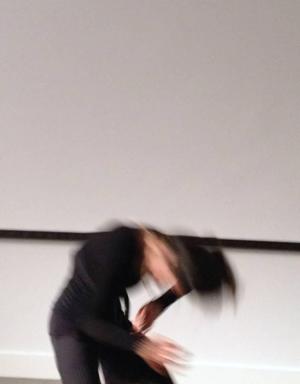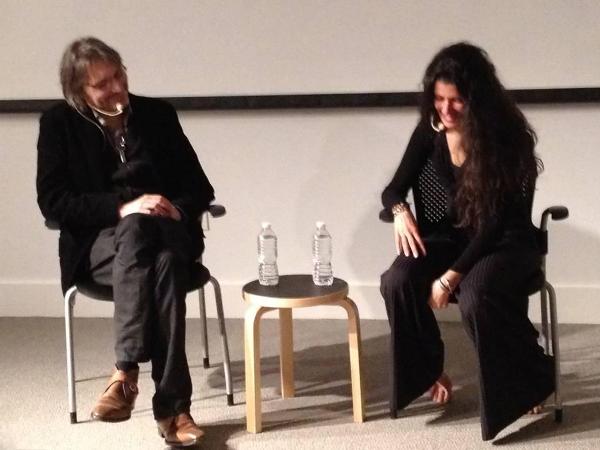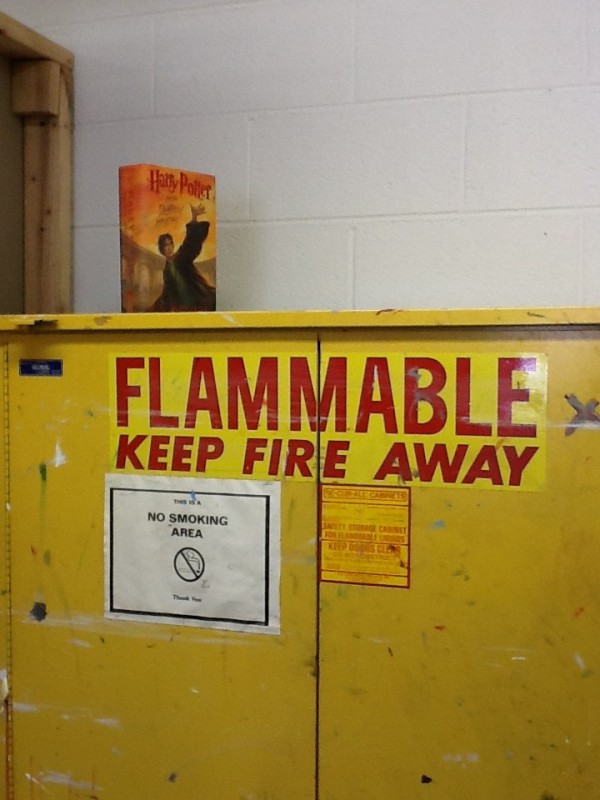
Janine Antoni dances the 5Rhythms. Photo: Meg Clark
After giving a brief overview of her work last Wednesday evening as part of the ongoing series Conversations with Artists, Janine Antoni calmly stepped away from her podium, took off her shoes, and walked to the center of the floor. Slowly she began to sway, moving her arms limply from side to side, gingerly tilting her head back, and lifting her feet. But she also continued to address everyone in the room, orally and physically guiding us through her movements of the dance, the 5Rhythms. “Our feet are on the same ground,” she told us, “you’re moving with me.” And as I leaned in closer, I noticed everyone around me was too.
Up until this point, I had only encountered Antoni’s work through research. I knew about her various pieces: rubbing one rock against another for a span of days in And (1996-99), tightrope walking over the ocean in Touch (2002), harnessing herself to a dollhouse replica of her home in Inhabit (2009)—and I understood that in all this, the artist was seeking connection between herself and other people. But I never felt connected. These works seemed too narrowly based in personal relationships of motherhood, womanhood, and love to include me. The nature of their subject matters and their intimacy seemed to belong exclusively to the artist.
But in sharing Antoni’s experience of dancing the 5Rhythms with both her and the audience, I began to feel connected.

Curator at Large Klaus Ottmann and Janine Antoni sit down for a conversation after her dance. Photo: Meg Clark
Toward the end of the evening, Antoni sat down for a conversation with Curator Klaus Ottmann. He spoke about the expression of love, relationships, and gentleness in Antoni’s work, asking, “Where does that come from?” In reply, the artist revealed her work stems from “a deep loneliness.”
Immediately, I harkened back to Antoni’s dance . . . “you’re moving with me,” she had said. Before this Conversation, I saw Antoni’s work as a private and personal journey into the bodies, thoughts, and feelings of others. I didn’t understand the role of the audience, the part I could play in Antoni’s work. I didn’t understand that my role was necessary to her art’s meaning. But when I felt Antoni’s feet pounding the floor, and when I heard her voice calling out to the audience, and me, I felt connected . . . I was moving with her. Suddenly, I didn’t feel alone that evening, and I don’t think Antoni did either.
I’ve found that Janine Antoni and every participant in the Conversations with Artists series has enhanced my understanding of their art, not only as ideas that must be talked about, but also as entities that must be experienced. To explore this season’s theme–Art as Experience–we began with Wolfgang Laib in October and continued with The Otolith Group, Jill Downen, Anthony McCall, and, of course, Janine Antoni. Tonight, the experience draws to a close at the season’s final Conversation with William Pope. L. It will be another packed program, but standing room may become available for those willing to come a bit early and wait in line. Hope to see you there!
Madeline Bouton, Center for the Study of Modern Art Intern







